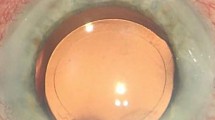Access this chapter
Tax calculation will be finalised at checkout
Purchases are for personal use only
Similar content being viewed by others
References
Masket S. Coaxial 2.2 mm microphaco technique reduces surgically induced astigmatism. Ophthalmol Times 2006; 31:41–42
Osher RH, Injev VP. Micro-coaxial phacoemulsification. Part 1: laboratory studies. J Cataract Refract Surg 2007; 33:401–407
MacKool RJ, Sirota MA. Thermal comparison of the AdvanTec Legacy, Sovereign WhiteStar, and Millennium phacoemulsification systems. J Cataract Refract Surg 2005; 31:812–817
Bissen-Miyajima H, Shimmura S, Tsubota K. Thermal effect on corneal incisions with different phacoemulsification ultrasonic tips. J Cataract Refract Surg 1999; 25:60–64
Osher RH, Injev VP. Thermal study of bare tips with various system parameters and incision sizes. J Cataract Refract Surg 2006; 32:867–872
Berdahl JP, DeStafeno JJ, Kim T. Corneal wound architecture and integrity after phacoemulsification; evaluation of coaxial, microincision coaxial, and microincision bimanual techniques. J Cataract Refract Surg 2007; 33:510–515
Stratas BA. Clear corneal paracentesis: a case of chronic wound leakage in a patient having bimanual phacoemulsifi-cation. J Cataract Refract Surg 2005; 31:1075
Weikert MP, Koch DD. Phaco wound study: alterations in corneal wound architecture with bimanual microincisional phacoemulsification. Cataract Refract Surg Today 2005; June:11–13
Praveen MR, Vasavada, AR, Gajjar D, Pandita D, Vasavada VA, Vasavada VA, Raj, SM. Comparative quantifi-cation of ingress of trypan blue into the anterior chamber after micro-coaxial, standard coaxial, and bimanual phacoemulsifi-cation. J Cataract Refrac Surg 2008; 34:1007–1012
Kaid Johar SR, Vasavada AR, Mamidipudi R, et al Histomorphological and immunofluorescence evaluation of bimanual and coaxial phacoemulsification incisions in rabbits. J Cataract Refract Surg 2008; 34:670–676
Vasavada AR. Phaco tips and corneal tissue: histomorphology and immunohistochemistry reveal the effects of sleeveless and sleeved tips. Cataract Refract Surg Today 2005; June:9–10
Taban M, Sarayba MA, Ignacio TS, et al Ingress of India ink into the anterior chamber through sutureless clear corneal cataract wounds. Arch Ophthalmol 2005; 123:643–648
Gajjar D, Mamidipudi R, Vasavada A, et al Ingress of bacterial inoculum into the anterior chamber after bimanual and micro-coaxial phacoemulsification in rabbits. J Cataract Refract Surg 2007; 33:2129–2134
Chee S-P, Bacsal K. Endophthalmitis after microincision cataract surgery. J Cataract Refract Surg 2005; 31:1834–1835
Boukhny M. Phacoemulsification tips and sleeves. In: Buratto L, Werner L, Zanini M, Apple D, eds, Phacoemul-sification Principles and Techniques, 2nd edn. Thorofare, NJ, Slack, 2003; 247–254
Ernest PH, Fenzl R, Lavery KT, Sensoli A. Relative stability of clear corneal incisions in a cadaver eye model. J Cataract Refract Surg 1995; 21:39–42
Masket S, Belani S. Proper wound construction to prevent short-term ocular hypotony after clear corneal incision cataract surgery. J Cataract Refract Surg 2007; 33:383–386
Dosso AA, Cottet L, Burgener ND, Di Nardo S. Outcomes of coaxial microincision cataract surgery versus conventional coaxial cataract surgery. J Cataract Refract Surg 2008; 34:284–288
Osher RH. Micro-coaxial phacoemulsification. Part 2: clinical study. J Cataract Refract Surg 2007; 33:408–412
Cionni RJ. Torsional to longitudinal phacoemulsification comparison. In: American Society of Cataract and Refractive Surgery Annual Meeting, San Francisco, 2006
Miyoshi T, Yoshida H. From phaco-cutting to true pha-coemulsification. VJCRS 2007; XXIII(4)
Fernandez de Castro LE, Sandoval HP, Vroman DT, Solomon KD. Fluid dynamics during phacoemulsification; fluid dispersion check model. In: American Society of Cataract and Refractive Surgery Annual Meeting, San Diego, 2007
Solomon K. Alcon CME Program, American Academy of Ophthalmology, San Fransisco, 2006
Osher J, Osher R. Understanding the dropped nucleus. Video J Cataract Refract Surg 2008; XXIV(4)
Boukhny M. Laboratory performance comparison of tor-sional and conventional longitudinal phacoemulsification. In: Annual Meeting of American Society of Cataract and Refractive Surgery, San Francisco, 17–22 March 2006
Allen D. Efficient surgery with a new torsional phaco mode. In: Annual Meeting of the American Society of Cataract and Refractive Surgery, San Francisco, 17–22 March 2006
Yoo S. Transitioning to torsional phaco emulsification. Cataract Refract Surg Today 2006; (supplement):7–8
Tjia KF. Efficiency of torsional versus longitudinal ultrasound. Cataract Refract Surg Today Europe 2008; May:33–34
Liu Y, Zeng M, Liu X, et al. Torsional mode versus conventional ultrasound mode phacoemulsification: randomized comparative clinical study. J Cataract Refract Surg 2007; 33:287–292
Johansson C. Quantitative comparison of longitudinal versus torsional phacoemulsification. In: European Society of Cataract and Refractive Surgeons Annual Meeting, London, 9–13 September 2006
Davison JA. Cumulative tip travel and implied followability of longitudinal and torsional phacoemulsification. J Cataract Refract Surg May 2008; 34:986–990
MacKool RJ. Lens removal/torsional phacoemulsification: advantages of nonlinear ultrasound. In: Annual ASCRS Symposium on Cataract, IOL, and Refractive Surgery, San Francisco, CA, 17–22 March 2006
Allen D. Cataract surgery evolves: new IOL implantation and fluidics technologies make transitioning to a micro-coaxial technique easier and safer. Cataract Refract Surg Today 2007; (Supplement):3–5
Davison JA. Beginning micro-coaxial surgery. Eyeworld Supplement May 2008
Henderson B, Grimes K. Comparison of surgical efficiency using different ultrasound modulation on dense lenses and using varied angled phacoemulsification tips. ASCRS, San Diego, 2007
Osher RH, Marques FF, Marques D.M.V, Osher JM. Slow motion phacoemulsification technique. Tech Ophthalmol 1(2):73
Vaz F, Osher RH. Early uncorrected visual acuity with micro-coaxial phacoemulsification and torsional ultrasound: an independent study. In: Annual Meeting of the ASCRS, San Diego, 2007.
Author information
Authors and Affiliations
Editor information
Editors and Affiliations
Rights and permissions
Copyright information
© 2010 Springer-Verlag Berlin Heidelberg
About this chapter
Cite this chapter
Osher, J.M., Osher, R.H. (2010). The Transition Towards Smaller and Smaller Incisions. In: Alió, J.L., Fine, I.H. (eds) Minimizing Incisions and Maximizing Outcomes in Cataract Surgery. Springer, Berlin, Heidelberg. https://doi.org/10.1007/978-3-642-02862-5_2
Download citation
DOI: https://doi.org/10.1007/978-3-642-02862-5_2
Publisher Name: Springer, Berlin, Heidelberg
Print ISBN: 978-3-642-02861-8
Online ISBN: 978-3-642-02862-5
eBook Packages: MedicineMedicine (R0)




